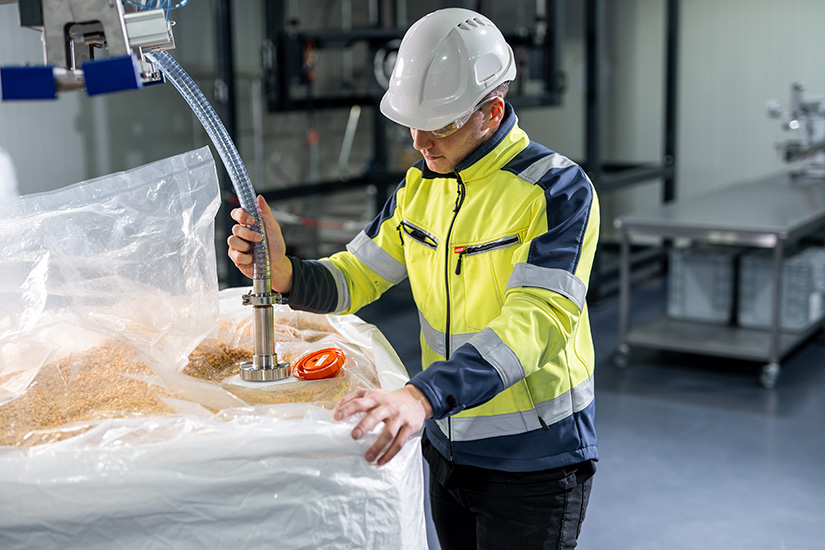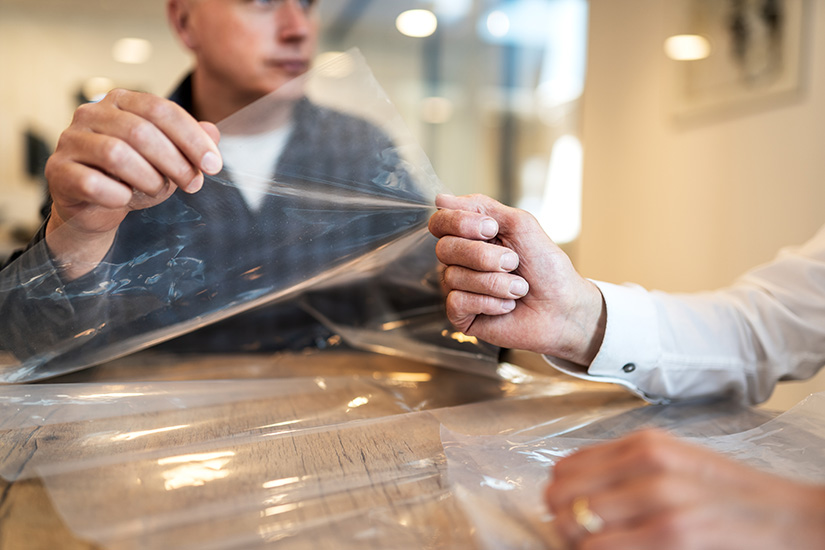Masterpack group's vision on sustainability
Sustainability isn't just a buzzword; it's a call to action. Dive deep into Masterpack Group's comprehensive approach to sustainability, from our pioneering technologies and innovative initiatives to our unwavering commitment to a greener tomorrow.
On this page, you'll discover how we intertwine sustainability with every facet of our operations, our ambitious goals, and the tangible steps we're taking to achieve them.
Masterpack Group's ambition
Masterpack Group seeks to be a catalyst for change, making a meaningful and lasting contribution to a more sustainable world. We envision a future where packaging plays a pivotal role in preserving and enhancing our planet’s resources, while also meeting the needs of our customers and society as a whole.
Our targets
- Reducing emissions: Masterpack strives to reduce her emissions by, for example, implementing energy-efficient technologies and adapting renewable energy sources.
- Adoption of the circular economy: Masterpack aims to transition to a more circular model by 2023 by reducing waste generation and promoting the recycling and reuse of materials. Within this target lies the specific goal to further the implementation of FIBCs containing recycled material.
- Social responsibility and employee well-being: Masterpack aims to prioritize social responsibility and employee well-being by implementing programs and initiatives, including regular health check-ups, a safe work environment, and the promotion of education.
Our Global Commitment to Sustainable Development Goals (SDGs)
Masterpacks’ targets are aligned with the Global Goals set by the United Nations in 2015. We contribute to 15 of the 17 Sustainable Development Goals (SDG's), actively working on 6 of the SDG's.

Modified atmosphere technology: an essential tool for sustainable supply chains
It’s not just about the products that people consume – although this plays a huge role as well. The packaging industry plays an equally important role in not only protecting these products, but making sure the supply chain is more sustainable.
With our innovations, we made Modified Atmosphere Packaging available for use in Big Bags and FIBCs, which can transform certain supply chains. Here’s how it works, and what effects it has.
The fundaments of modified atmosphere packaging
Modified Atmosphere (MA) Technology represents a pivotal advancement in product packaging, designed explicitly for preserving product integrity. By adjusting the internal environment of a package, MA modifies the air composition, often replacing certain volumes of oxygen with other gasses like nitrogen or carbon dioxide.
This isn't just a random alteration; it's a carefully calculated move, with the primary objective of significantly extending the shelf life of perishable goods.
Driving sustainability through MAP
In the broader context of global sustainability challenges, the efficacy of MA technology in mitigating food waste stands out prominently. An alarming proportion of food is discarded globally due to premature spoilage, representing not only a waste of the food itself but also of the water, energy, and labor invested in its production.
By extending the shelf life of products, MA directly addresses this issue, considerably reducing the amount that reaches landfills.
Moreover, this increased longevity of products translates to logistical benefits. Consumers can store products for longer durations, leading to fewer trips to replenish supplies.
On the supply chain side, longer product life means reduced frequency in restocking, translating to more streamlined logistics, reduced transportation needs, and consequently, a decrease in associated emissions.
Incorporating precision with Somsix Sensor Technology
For successful Modified Atmosphere Packaging, it's paramount that you keep the oxygen levels inside the Big Bag below 0.1% at all times. That means you can’t just open the bag to check.
To ensure the optimal atmospheric conditions within each package, non-invasive sensors play a crucial role. We provide both standard and custom solutions with Somsix.
This technology provides real-time monitoring capabilities, allowing for precise adjustments to the gas composition based on the specific requirements of the enclosed product.
Whether it's fresh produce or delicate dairy items, these sensors guarantee a tailored environment that upholds the product's freshness and prolongs its usability.

sustainable FIBC innovations
We take care of the products in our packaging with MAP, but we also look at how we can make the actual packaging material and process more sustainable. Here’s what we’ve been working on.
Recycling FIBCs
There's a lot being said and written about recycling plastics, including FIBCs. The truth is, however that it isn't easily done. Some of the challenges include:
- Material Complexity: FIBCs are often made of multiple materials. While the primary component is usually polypropylene (PP), they can have inner liners, labels, and stitching made of different materials. This makes separation and recycling processes more complex.
- Contamination Concerns: After use, FIBCs can be contaminated with the materials they used to store. Whether it's food products, chemicals, or construction materials, this contamination can interfere with the recycling process, making it less efficient and, at times, impractical.
- Degradation Over Time: FIBCs are designed for strength and durability, meaning they can withstand multiple uses. However, over time, exposure to UV rays, physical stress, and environmental factors can degrade the quality of the plastic. This degradation can affect the integrity of the recycled material.
Economic Viability: Setting up infrastructure for recycling specialized items like FIBCs requires investment. The return on this investment is based on the value of the recycled material. Given the complexities involved, recycling FIBCs might not always be economically viable when compared to producing new ones.
Recycling FIBCs
From early 2023 it’s possible to order a Masterpack big bag containing 30% recycled materials, but we’re ready for the next step. Scaling up the availability and usage of regranulate, preferably from our own big bags, to create a steady flow.
Masterpack Group offers FIBCs with 30% post-consumer regranulate, sourced exclusively from our trusted partner in the Netherlands. By incorporating our own FIBCs, we ensure the highest standards of regranulate quality.
Whenever big bags can't be recycled into new big bags, the regranulate is used for other products such as poles. But it doesn't end there – we're committed to scaling up production of FIBCs with PCR. That's why we invite our customers to join the recycling movement by submitting their used FIBC's to our dedicated partner.
Collaborating in our home country for fibc recycling
Our collaboration with our partner in the Netherlands has been ongoing for several years, but in June 2023, we drafted a new plan to gather plastic for our FIBCs made with recycled materials. Our partner specializes in recycling big bags, and we are incorporating this post-consumer recyclate back into our production of FIBCs.
With this initiative, our aim is to partly close the loop and reduce the usage of virgin plastic. Furthermore, with numerous countries in the EU having introduced plastic taxes, through a big bag with PCR, we hope to help our customers meet the requirements regarding plastic taxes in the near future.
Greenfilm
In collaboration with one of our customers, we introduced the Greenfilm. A game-changing liner designed to be recycled within the stringent standards of the food industry
Aluminium replacement
By swapping out aluminum liners, and welcoming our completely recyclable alternative, with its exceptional WVTR-value, we ensure product protection while minimizing environmental impact.
Reusing and reconditioning fibcs
Reusing FIBCs should only be done under specific circumstances that can guarantee the safety of the products and the people handling the big bags. Strict standards regarding if and when a Big Bag can be reused are in place. According to the Safety Factor you can see if it’s a single-use, double-use or multiple-use Big Bag
Another option is reconditioning FIBCs: where Big Bags are collected, cleaned, and repaired, making them ready for reuse. This lengthens the lifespan of an individual bag but can be an expensive process. One has to take into account where the bag has been, which products it has transported, and what products it’s supposed to transfer in the future.
Shipping Big Bags back and forth over the world has its own impact on the environment and should, therefore, be carefully measured and carried out.
Reducing material needed for liners
Not everything can be recycled; that's why it's crucial to start at the beginning, and make sure we don't overuse or waste any material.
The traditional way of creating liners is by cutting and shaping them from big tubular PE film, the so-called bottle-shaped liner. This is rarely exactly accurate and often needs to be tailored even more, leading to unnecessary waste material.
Masterpack does things differently. We design and fabricate PE films that are exactly the right size for our custom-made liners, so we don’t have to cut any surplus material. This saves 10 to 20 percent on waste per liner and tons of kilos on a yearly basis.
We’ve also introduced the Powertube and Powercube, where innovative product design allows us to achieve a remarkable 20% reduction in the materials used.
Reducing material needed for liners
Sustainability is not a one-size-fits-all strategy. Here at Masterpack, we’re continuously looking for new ways to make our impact on the planet more positive.
Unicef’s Plastic Bricks Project
Masterpack is a proud contributor to Unicef's 'Plastic Bricks' project. By transforming plastic waste into building blocks, we're constructing classrooms across Africa and opening doors to education.
Future-proofing our own headquarters
Our commitment to sustainability shines brightly in our headquarters and warehouse. The headquarters is powered by solar panels that extend their eco-friendly touch to our warehouse across the street. The renewable energy generated also allows us to use electric forklifts in our warehouse.
We commit to our planet, our people
Taking care of our planet means also taking care of our people. For all our manufacturing plants across the globe, we make sure that our employees can work under safe conditions. We believe that combining economic success with environmental protection and social responsibility is the only real, sustainable way of doing business.
SMETA 4 Pillar certification (Sedex Members Ethical Trade Audit)
In our manufacturing plant in Bangladesh, we started a project that gives employees and their families more opportunities in education. This is in line with our SMETA 4 Pillar certification. The two pillars mandatory for any SMETA audit are Labor Standards and Health & Safety. The two additional pillars of a 4-pillar audit are Business Ethics and Environment.
Employee Well-being and SA8000 Implementation
Alongside our SA8000 implementation, we also launched an education project. By investing in the education of our employees and their families, we're empowering communities and shaping a brighter future.
Recognition and the road ahead
Masterpack’s commitment to sustainability has been recognized by Ecovadis, the world’s most trusted sustainability rating agency. Ecovadis evaluates companies based on their environmental, social, and ethical performance.
Starting with EcoVadis in 2014, we embarked on a path of continuous improvement, initially achieving the bronze status. By 2021, our consistent efforts were recognized with the silver badge. Today, we take pride in belonging to the top 5% of companies, having achieved the Gold status.
Our trajectory to Gold was built on strategic pillars, notably focusing on Labor and Human Rights, Environment, and Sustainable Procurement. Partnering with NEXIO PROJECTS played a pivotal role, guiding us every step of the way. This involved the formulation of robust policies, setting ambitious targets, refining our procedures, and pursuing relevant certifications, all of which collectively brought us closer to our esteemed goal.
While achieving Gold is a commendable feat, our sights are set even higher. With the expertise of our Lead Sustainability, Carlijn van der Zanden, we aim to further our commitment, with the hope of making an even broader positive impact in the future.
The path to a greener future is one best walked together
If you are serious about strengthening your supply chain, aligning with responsible practices, or driving sustainability at the core of your business, we're here to collaborate. Get in touch with our team today.

